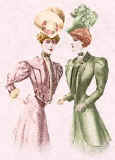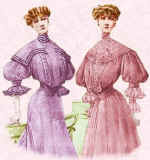What is La Belle Époque?
Aspects of Edwardian fashion history are examined in the sections on the Society Hostess, The Edwardian Seamstress and Edwardian Corsetry. Here we give a general overview of the main popular styles in the period 1890-1914 by which time fashion moved in a yearly cycle.The French called the era from 1895 to 1914 La Belle Époque. It was an epoch of beautiful clothes and the peak of luxury living for a select few - the very rich and the very privileged through birth.
In retrospect we can see it is an era very separate from the 20th century despite belonging at its start. The attitudes and lifestyles of two decades were swept away by war and because the war was so atrocious a new socialism and sense of personal identity was born. The masses started to reject the concept of privilege as the reason for a better life. Clothes worn after 1915 could probably be worn today in certain circumstances, but clothes before then are more in tune with the elaborate clothes of 1770 and would only be seen today at a costumed event or as bridal wear.
The Silhouette after 1890
 The bustle disappeared from day dresses and the new day skirt style was flared smoothly over the hips from a handspan waist and then gradually widened at the hemline.
The bustle disappeared from day dresses and the new day skirt style was flared smoothly over the hips from a handspan waist and then gradually widened at the hemline.
By 1895 the leg of mutton sleeves swelled to gigantic proportions and were also used on décolleté evening dresses. The size of the sleeves was highlighted by the comparison of the tiny sashed or belted waist against the simple gored skirt that flared out all round to balance the massive sleeve heads.
Hostess beauties of the 1890s. Left - Mary Moore, right - Grace Palotta
Tailor Made Ready to Wear Costumes
The tailor made was called a costume or a suit and made of wool or serge. Middle and upper class women wore them with shirtwaist blouses. Looser less fitted versions of a simple suit had been available for informal wear since 1850. But the tailored suit as we know it was first introduced in the 1880s by the Houses of Redfern and Creed. Initially only the jacket was tailored and it was worn with a draped bustle skirt.
By the 1890s and until 1910 the gored skirt also looked more tailored and matched the jacket style which followed the changing silhouette of the time. In the 1890s the tailored suit was thought both masculine and unladylike, a description usually used for a fairly plain garment. Describing female clothes as masculine was intended to be derogatory.
Edwardian tailored suits ideal for travel.
The pink tailor made shown left here has a short bolero effect jacket. The second green jacket is a longer line jacket that continued in popularity, but became straighter and less waisted toward the end of the Edwardian era. »
Tailor mades were always described as ideal for travelling. Within a decade they became much more versatile with a distinction being made between the cloths used. Lighter cloths were used in tailor made outfits suitable for weddings and heavier tweeds and rougher serge used for everyday or country wear suits.Fashion history clearly shows that by 1900 tailored suits were firmly established. Women entering a changing, more commercial workplace found it a useful all purpose outfit. Men objected to the tailor made female suit as they saw it representing a challenge to their authority. Women seemed to be making a clear statement that they deserved and wanted more independence in the future.
The Gibson Girl
 This particular image was a cartoon character drawn by the American artist Charles Dana Gibson. For twenty years between 1890 and 1910 he satirised society with his image of 'The New Woman' who was competitive, sporty and emancipated as well as beautiful.
This particular image was a cartoon character drawn by the American artist Charles Dana Gibson. For twenty years between 1890 and 1910 he satirised society with his image of 'The New Woman' who was competitive, sporty and emancipated as well as beautiful. Right - The Gibson Girl.
Her clothes were fashionable in both America and Britain and set a fashion for skirts worn with embroidered blouses.Another Gibson look was a shirt collar worn with either a tie, floppy artist bow, tie neck cravat with stick pin bar brooch or crosscut ruffle jabot.
Beautiful embellished ornate blouses took on a new importance and were worn by every class. Home dressmakers did their best to emulate the fussy couture blouses and they used fine pin tucks, fine embroidery, appliqué, insertions of lace, faggoting, pleats and lace trim to get good effects. Blouses are detailed in the section on the Edwardian Seamstress.
The Edwardian Silhouette 1900-1907
»
 The fashionable hour glass silhouette belonged to the mature woman of ample curves and full bosom. The S-bend health corset described fully in the section on Edwardian Corsetry set the line for fashion conscious women until 1905. The corset was too tightly laced at the waist and so forced the hips back and the drooping monobosom was thrust forward in a pouter pigeon effect creating an S shape.
The fashionable hour glass silhouette belonged to the mature woman of ample curves and full bosom. The S-bend health corset described fully in the section on Edwardian Corsetry set the line for fashion conscious women until 1905. The corset was too tightly laced at the waist and so forced the hips back and the drooping monobosom was thrust forward in a pouter pigeon effect creating an S shape.The S-Bend corset and pouter pigeon effect.
If you were wealthy like an Edwardian society hostess, cascades of lace and ultra feminine clothes were available as labour was plentiful and sweated.
During this time it was still usual to make dresses in two pieces. The bodice was heavily boned and was almost like a mini corset itself worn over the S-bend corset.
A top bodice was usually mounted onto a lightly boned under bodice lining which fastened up with hooks and eyes very snugly. It acted as a stay garment giving extra stability, contour and directional shape beneath the delicate top fabric.
By 1905 press fasteners were used in Britain to hold the bodice or blouse to a skirt, but America had dress fasteners as early as 1901.
Above Left - Bodice pouched Edwardian day dresses
At the front of the bodice, pouches of cascading lace or gathered fabric gave emphasis to the low bust line. The straight sleeves of the late 1890s developed into bloused effects gathered into wrist bands.
Very deep high lace fabric collars that reached right under the chin elongated the neck. They
 were often kept in place with wire covered in silk that was twisted into a series of hooks and eyes from one piece of wire. Little wire or boning supports covered with buttonhole silk were sometimes dispersed every few inches of the collar to maintain the rigid effect. Right - High neck blouse 1906.
were often kept in place with wire covered in silk that was twisted into a series of hooks and eyes from one piece of wire. Little wire or boning supports covered with buttonhole silk were sometimes dispersed every few inches of the collar to maintain the rigid effect. Right - High neck blouse 1906.  High necks were usual by day, but by night exceptionally low sweetheart, square and round décolleté necklines allowed women to wear quantities of fine jewellery. No cleavage was visible as the bust was suppressed into a monobosom.
High necks were usual by day, but by night exceptionally low sweetheart, square and round décolleté necklines allowed women to wear quantities of fine jewellery. No cleavage was visible as the bust was suppressed into a monobosom.The skirts were often gored and created an elongated trumpet bell shape like the gently opening head of a longiflorum lily. Modified versions were less extreme over the hips, simply flowing to more width at the hemline.
Right - The S-Bend Silhouette.
The high collar, S bend corset, trained skirt and lavish hat all had an effect on the posture of an Edwardian lady and it gave her a certain swaying grandeur. Between 1906 an 1909 the silhouette began to show gradual changes and skirts lost fullness and the silhouette straightened. Feet showed again. ˚
The Edwardian Silhouette 1908-1913
 The waistline was raised until it was a column like empire line or Directoire after the styles designed by fashion designer Paul Poiret. So after 1907 fashion history looked toward a new fresh direction when a longer line corset became fashionable. The corset almost reaching the knees was intended to make the figure look slimmer.
The waistline was raised until it was a column like empire line or Directoire after the styles designed by fashion designer Paul Poiret. So after 1907 fashion history looked toward a new fresh direction when a longer line corset became fashionable. The corset almost reaching the knees was intended to make the figure look slimmer. Poiret's ideas were controversial and were directed at younger women. To read more about the era of Orientalism and Paul Poiret's artist friends who put a stamp on the era go to Orientalism In Dress. One of THE social events of 1908 was the London Olympic Games.
The new late Edwardian silhouette. See more silhouettes of the Edwardian era and use them for colouring in sheets of fashion history.
If you like this page then please share it with your friends
Paletots, Casaques and Mantelets
»
The Casaque was a deep close fitting basque jacket that buttoned to the neck. A Paletot was a short jacket with set in sleeves and the Mantelet was a kind of half shawl. All the items had allowed for the cut of the bustles and pads of the era and the garments ranged from high hip to three quarter length.
Edwardian Small Accessories
Incredible Edwardian Hats
After the slimmer silhouette arrived, hats developed much wider brims. Lavish trims such as feathers often stuck out well beyond the brim. The hats were named Merry Widow hats after the popular operetta of the era. Read more about Edwardian hats here.
Picture Hat - Fashion plate courtesy of alldressforms.com where this plate is for sale.
Feathers
Feathers were used excessively as decoration on hats and as boas. The fur skin of whole animals such as foxes and even two foxes were used as wraps about the shoulders. Aesthetes objected to the use of animal products.Right - Martial and Armand Creation depicting the perfectly groomed directoire styled woman of 1912.
Note the incredible feather hat and lavish gold metal embroidery, velvet and fur trim on the oversized muff.
No comments:
Post a Comment